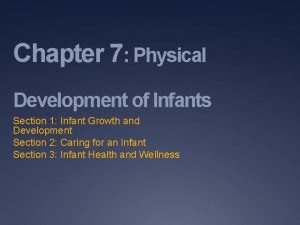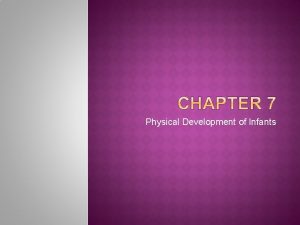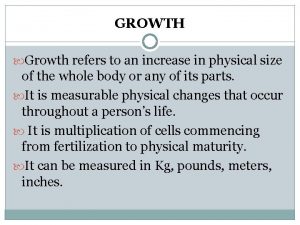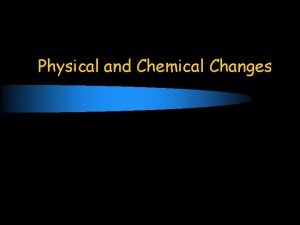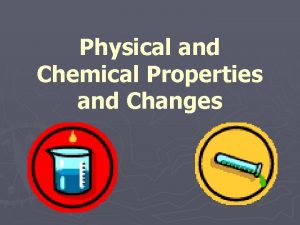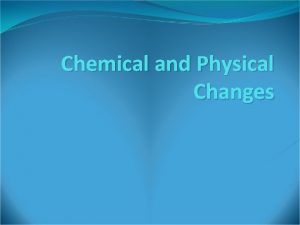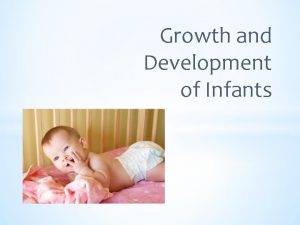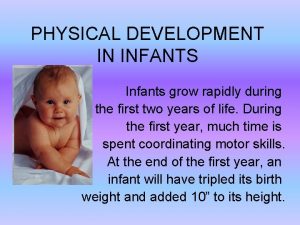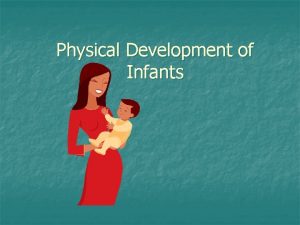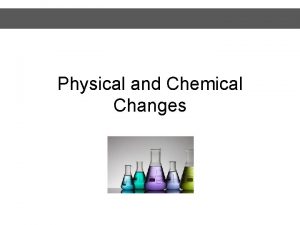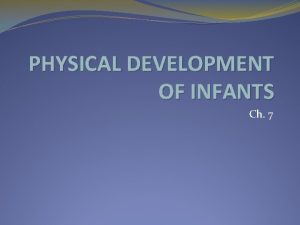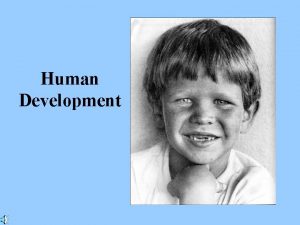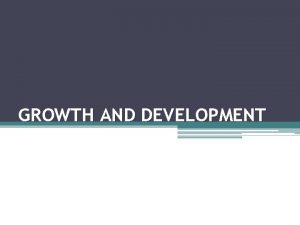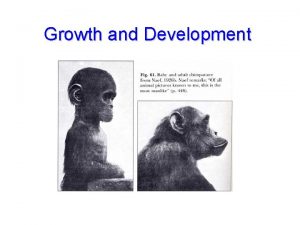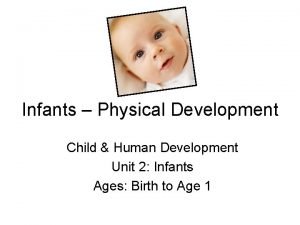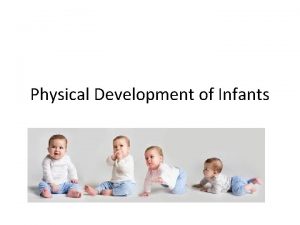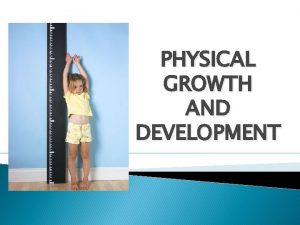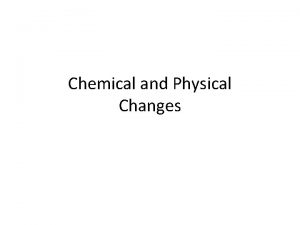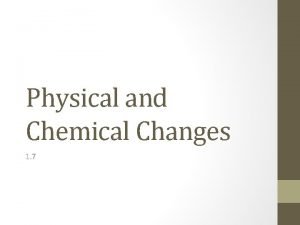Physical Development of Infants Growth refers to changes













































- Slides: 45

Physical Development of Infants

Growth refers to changes in size such as weight or length. Development refers to increases and changes in emotional, social, intellectual, and physical SKILLS.

Head to foot Near to far Simple to complex

Movement of head starts prenatally. After birth, raise head to see objects. Then muscle control moves down to arms and hands. Usually by age 1, baby’s legs and feet have developed skills to begin walking.

� Development starts close to trunk (legs, neck, arms, torso) of body and moves outward. � At first, babies wave arms when they see an object they want. Later they reach out and grasp object.

� Develop large muscles of the trunk first, then small muscles (like in the fingers). � Move from simple (rolling, walking, etc. ) to complex (grasping and directing a crayon).

Heredity (nature) Environment (nurture)

Definition: the physical makeup from the parents. Doesn’t mean person automatically inherits traits (Ex. Someone’s genes may give him the potential to be musically gifted but if never given opportunity to sing or play an instrument (i. e. nurture), the talent may never develop.

Includes influences such as Nutrition Amount of stimulation Health Relationships

Affects physical G & D such as bone strength, brain development, and height Not getting enough calories or necessary nutrients puts baby at risk for illness, delayed growth or even death.

Critical to brain development. Need a world where all senses can be used. Experiences should happen frequently and have variety. Experiences are stored in the brain and connections are made (high chair = food) Lack of stimulation can delay development in other areas. Ex. Infants aren’t born with language skills. They must be exposed to language and encouraged to talk.

Healthy baby eats well Activities cause hunger, require fuel from healthy eating Activities stimulate brain, develop muscle Eating well creates energy Energy leads to different activities

Even babies can enjoy simple interactive play. � Babies enjoy listening to music, clapping hands together, hearing an adult sing nursery rhymes, etc. � Baby play promotes physical and brain development and social interaction. � Nurtures baby’s sense of security and well-being. �

Section 7 -1 cont’d

Very few babies match the average measurements on growth charts because children grow at individual rates.

Weight gain is 1 of the best signs of good health in newborns. Newborns lose about 10% of birth weight in first five days of life. Babies triple weight from birth to 1. Length increases 50%. Boys = weight slightly more and are slightly longer than girls during babyhood. Heredity more strongly influences height than weight.

Newborns – skinny arms and legs, abdomen large, head may be elongated from trip through birth canal Umbilical cord usually falls off within 3 weeks. A baby’s head grows rapidly within the first year to accommodate the growing brain.

First week – blurry Week 2 to one month – 7 -10 inches and 2 dimensional (like a picture), eyes may appear crossed at times (disappears after abt 4 months) Month 1 - 6 months – 3 feet and demonstrate depth perception (3 D), eye muscles strengthen 6 months plus – clarity and sharpness of an adult Babies prefer high contrast patterns

� Develops before birth � By age 7 months, babies recognize parents by voice � Language dev. begins by hearing, imitating, then understanding. � Prematurity or frequent ear infections can delay language acquisition

Meeting children’s needs with a gentle touch builds trust. In the first year, babies begin to notice different textures (soft blanket, father’s scratchy beard, etc. )

� Smell develops after birth. � Within 10 days of birth, they can distinguish the smell of their mother from other people. � By 2 weeks, babies can distinguish some tastes. � Babies put things in their mouths as a way of learning about their world.

� Voice changes as lungs mature and throat muscles, lips, teeth, and vocal cords grow. � By age 1, most babies can imitate speech sounds and understand simple phrases.

Gross motor skills Involve large muscles like legs, shoulders By 9 months, many babies are crawling. Between 10 and 12 months, many babies are walking a few steps alone. Fine motor skills Involves smaller muscles like fingers At 7 mos, babies “rake” at objects. Between 9 and 12 months, they fine-tune their ability to self-feed, drink from a cup, and pick up objects with thumb and forefinger.

– instinctive, automatic responses, many of which help them survive the first several weeks of life. � The sucking reflex – stimulated when something, such as a bottle, is put in the baby’s mouth. The rooting reflex automatically turn and make sucking (rooting) motions with the mouth when the cheek/lip is touched. The rooting reflex ensures successful breastfeeding.

-Ability to move hands and fingers precisely in relation to what is seen Essential for many tasks in life Eating Catching a ball Coloring pictures Tying shoes By 1 year, most babies can pick up an object and put it in another place. Certain toys can help develop handeye coordination.

Section 7 -2 Infant Care Skills

Handling Babies Newborn’s neck muscles aren’t strong enough to support the head. By 4 months, babies can hold their heads up without support. Photo from Dipity. com

Shaken Baby Syndrome Also called Abusive Head Trauma Pitches the infant's brain back and forth within the skull Ruptures blood vessels and nerves throughout the brain and tears the brain tissue. brain may strike the inside of the skull, causing bruising and bleeding to the brain. Can lead to mental retardation, cerebral palsy, blindness, broken bones, neck injuries, or even death.

Sleep Essential for growth and development. Babies, children and teens – sleep coincides with release of chemicals that contribute to growth. Avoid pillows, fluffy blankets, and toys in bed with sleeping baby.

Sleep cont’d Babies should be face up for safety. Consistent bed time with a routine. Experts recommend go to a crying baby and comfort without picking up.

Sleep Patterns Newborns =16 hours (includes naps) 3 month olds = 14 -15 hrs (longer sleeping at night plus naps) 1 year = 12 hrs (9 -10 hrs of this at night)

Feeding Babies Year 1 - baby’s basic source of nutrition is breast milk or formula. Around 6 mos. , introduce solid foods such as watery cereal, strained fruits, vegetables, and meats. 8 mos = ½ formula/bm and ½ solid food 1 year = most nutrition from solid food Under 1 yr = no cow’s milk/hard to digest Fruit JUICE promotes tooth decay/may curb appetite…wait to 6 mos. and limit.

Breast vs. bottle feeding Breast Contains all nutrients Natural antibodies Germ free/easy digest Get fewer ear and respiratory infections, allergies Less likely to develop asthma Bottle Specially made to meet needs Cow’s milk or soy convenient

Feeding Doctors recommend newborns be fed as much and as often as they want Breast fed = 8 -12 x a day Bottle = every 3 -4 hrs Typically at 12 lbs, babies no longer need a late night feeding because stomachs hold more Burping Try to burp twice Spit up is common from time to time

WEANING Will show signs when ready Typically occurs between 9 -12 mos. Signs Playing while feeding Pushing away Showing a preference from eating from the spoon

Solid foods Introduce each new food 4 days apart. Makes it easier to identify trouble foods. 8 -10 months = introduce finger foods such as dry toast, cereal, small pieces of chicken, pasta, banana

Chapter 7 Section 3 Infant Health and Wellness

Objectives TLW Demonstrate how to bathe a baby Demonstrate how to diaper a baby Describe the signs of teething Describe at least 5 important ways to keep baby safe at home. Explain why checkups and immunizations are important.

Bathing a Baby… Newborns have sponge baths until navel heals. Portable baby tubs, large dishpans, or sinks are great alternatives to large tubs. By ages 2 to 3 months, babies should have baths 2 -3 times a week. Cradle cap – yellow, crusty patches on the scalp – can be treated by washing the baby’s scalp daily with mild shampoo. Do not use baby oil or shampoo excessively or it may become worse.

Diapering… Very young babies may need 12 -15 diaper changes daily. Diaper rash – rough, irritated skin caused by bacteria in the diaper. Severe- treat with medicated creams Mild – change diaper more frequently & clean diaper areas well Allow area to air out. No waterproof pants.

Diaper types… Disposable Convenient, more sanitary, keep drier Sensitivity, environmental waste Cloth Economical, environmental friendly Time-consuming

Diapering Steps… Teeth… Remove diaper and clean the baby with wipes/washcloths. Hold baby’s ankles together and slide new diaper underneath. Dispose of used supplies. Signs of teething With first teeth, wipe with washcloth or baby’s toothbrush At 6 mos. , if local drinking water doesn’t contain fluoride, ask doctor about supplement.

Keeping Baby Safe… Keep floors clear of small objects. Keep all plastic bags away from infants. Do not leave babies alone in or near water. Keep all poisons out of reach of children. Use safety covers on electrical outlets. Never leave vulnerable to animals, pets. Make sure sleepwear is flame retardant.

Regular Checkups… Pediatricians will do first checkup before you leave hospital. Follow up visit within the next two weeks. Visits at 1, 2, 4, 6, 9, and 12 months to track baby’s growth and development. Immunizations are required for daycare and school. Immunization causes the body to create antibodies that will be present if the baby is exposed to a sickness. This will enable baby to fight off or get a milder case of the sickness.

Signs of possible illness… Irritability Lack of energy Constipation/diarrhea Nasal congestion Persistent coughing Rashes Vomiting Fever
 Chapter 7 physical development of infants
Chapter 7 physical development of infants Growth refers to
Growth refers to Physical changes
Physical changes Chapter 9 intellectual development of infants
Chapter 9 intellectual development of infants Personality development in infants
Personality development in infants Summer camp 2014
Summer camp 2014 Elizabeth mulroney
Elizabeth mulroney Growth refers to
Growth refers to Growth refers to
Growth refers to Durganand sinha ecological model class 11
Durganand sinha ecological model class 11 Synchronous culture
Synchronous culture Relative growth rates
Relative growth rates Root hair structure
Root hair structure Growthchain
Growthchain Primary growth and secondary growth in plants
Primary growth and secondary growth in plants Chapter 35 plant structure growth and development
Chapter 35 plant structure growth and development Geometric growth vs exponential growth
Geometric growth vs exponential growth Neoclassical growth theory vs. endogenous growth theory
Neoclassical growth theory vs. endogenous growth theory Organic growth vs inorganic growth
Organic growth vs inorganic growth Physical changes in old age
Physical changes in old age Physical change
Physical change Compare and contrast physical and chemical changes
Compare and contrast physical and chemical changes What happens to boys during puberty
What happens to boys during puberty Physical and chemical changes
Physical and chemical changes Physical property examples
Physical property examples Is sawing wood a chemical change
Is sawing wood a chemical change What is a physical change
What is a physical change Generation genius physical and chemical changes
Generation genius physical and chemical changes Physical l change
Physical l change Cool physical changes
Cool physical changes Chemical change and physical change
Chemical change and physical change Physical changes outside
Physical changes outside Difference between chemical and physical change
Difference between chemical and physical change Physical development in young adulthood
Physical development in young adulthood 3 physical changes
3 physical changes Cognitive development in early adulthood
Cognitive development in early adulthood Physical changes lesson 3 outline
Physical changes lesson 3 outline Lesson 3 physical and chemical changes answers
Lesson 3 physical and chemical changes answers Whats chemical change
Whats chemical change Lesson 2 physical properties answer key
Lesson 2 physical properties answer key Physical and chemical changes jeopardy
Physical and chemical changes jeopardy Infancy physical changes
Infancy physical changes An example of a physical change
An example of a physical change Physical and chemical changes examples
Physical and chemical changes examples Physical/chemical changes & properties color by number
Physical/chemical changes & properties color by number Chemical properties of fire
Chemical properties of fire
